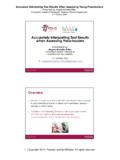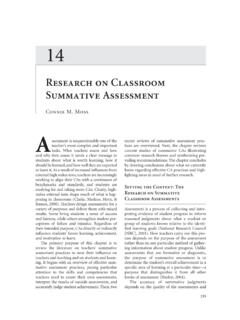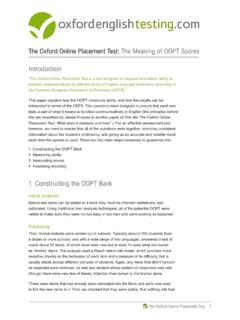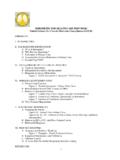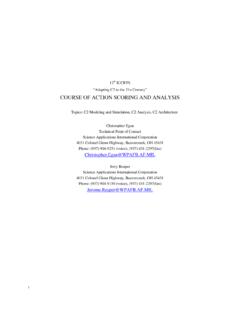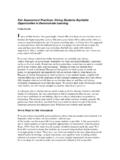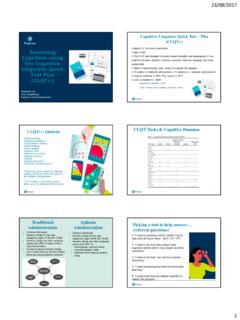Transcription of The Advantages and Disadvantages of Using Qualitative and ...
1 Journal of Education and Learning; Vol. 6, No. 1; 2017 ISSN 1927-5250 E-ISSN 1927-5269 Published by Canadian Center of Science and Education 102 The Advantages and Disadvantages of Using Qualitative and Quantitative Approaches and Methods in Language Testing and Assessment Research: A Literature Review Md Shidur Rahman1 1 School of Social Sciences, Education and Social Work, Queen s University Belfast, Belfast, UK Correspondence: Md Shidur Rahman, 69-71 University Street, Queen s University Belfast, BT7 1HL, Belfast, UK. Tel: 44-078-9498-7320. E-mail: Received: July 23, 2016 Accepted: October 14, 2016 Online Published: November 10, 2016 URL: Abstract The researchers of various disciplines often use Qualitative and quantitative research methods and approaches for their studies.
2 Some of these researchers like to be known as Qualitative researchers; others like to be regarded as quantitative researchers. The researchers, thus, are sharply polarised; and they involve in a competition of pointing out the benefits of their own preferred methods and approaches. But, both the methods and approaches ( Qualitative and quantitative) have pros and cons. This study, therefore, aims to discuss the Advantages and Disadvantages of Using Qualitative and quantitative research approaches and methods in language testing and assessment research. There is a focus on ethical considerations too.
3 The study found some strengths of Using Qualitative methods for language assessment and testing research such as, eliciting deeper insights into designing, administering, and interpreting assessment and testing; and exploring test-takers behaviour, perceptions, feelings, and understanding. Some weaknesses are, for instance, smaller sample size and time consuming. Quantitative research methods, on the other hand, involve a larger sample, and do not require relatively a longer time for data collection. Some limitations are that quantitative research methods take snapshots of a phenomenon: not in-depth, and overlook test-takers and testers experiences as well as what they mean by something.
4 Among these two research paradigms, the quantitative one is dominant in the context of language testing and assessment research. Keywords: Qualitative and quantitative research, Advantages , Disadvantages , testing and assessment 1. Introduction Qualitative and quantitative research approaches and methods are usually found to be utilised rather frequently in different disciplines of education such as sociology, psychology, history, and so on. Concerning the research approaches, there persist so-called paradigm wars in which researchers belong to the two distinct camps interpretivism and positivism.
5 The positivistic researchers belief is that the social world consists of concrete and unchangeable reality which can be quantified objectively. Whereas, the interpretive researchers oppose the positivistic belief of reality; and argue that, instead, the reality is socially constructed by the humans which can be changed and understood subjectively (Corbetta, 2003; Marcon & Gopal, 2005; Kroeze, 2012). As focused on the paradigm wars, there are some arguments about the superiority of research methods: Whether Qualitative evidence is superior to quantitative evidence, or vice-versa. In this regard, there is a need to highlight the history of the emergence of paradigms in order to understand the dominant method in the arena of research.
6 For the first half of the twentieth century, the positivist model was dominant in social and educational research by giving importance of Using standardised tests and systematic observation, experiment, survey data, and statistical analysis. In other words, the quantitative research method was quite powerful. However, after the 1960s, because of the influence of Kuhn s work, the new approaches such as, symbolic interactionist ethnography, critical research, feminist, phenomenography, discourse analysis and other forms came up into practice (Hammersley & Traianou, 2012). That is to say, there was a shift of research methods from quantitative to Qualitative , and the superiority of quantitative research was not as powerful as before.
7 The growth of Qualitative research was also from the unhappiness with the process of generating knowledge within the positivistic research (Sandberg, 2005). Alongside the research methods and approaches, ethical considerations were also introduced in the research world though it was subsequent to research methods and approaches. Up to Journal of Education and Learning Vol. 6, No. 1; 2017 103 this point, it is obvious that a various types of research techniques and methods were employed in different areas of Qualitative and quantitative research.
8 Likewise, the language testing, as an area of, research has encountered a vast array of methods and approaches (Bachman, 2000), for example, VELC Test score interpretations technique used by Kumazawa, Shizuka, Mochizuki, and Mizumoto (2016); Exploratory Factor Analysis (EFA) and Confirmatory Factor Analysis (CFA) employed by Sims and Kunnan (2016); action research in Cambridge English Language Test (Borg, 2015; Watkins, 2015; Depieri, 2015). The study aims at critically discussing the Advantages and Disadvantages of Using quantitative and Qualitative approaches and methods for language testing and assessment research.
9 The study begins with an introduction to the background of research methods and approaches (quantitative and Qualitative ). The introduction is followed by a brief description of language testing and assessment. Then, it presents the pros and cons of Using Qualitative and quantitative approaches and methods; and evaluates the dominant research methods in language testing and assessment research. Finally, ethical considerations are also pointed out. 2. Language Testing and Assessment In a general sense, a test is something that demonstrates one s competence-incompetence, ability-inability; and that shows someone s position in the scale consisting of variables such as fail, pass, average, satisfactory, good, and excellent.
10 An academic test also helps taking an important decision of whether or not a student will be allowed to move up to the next step. It can check the progress of a student and suggest whether a student needs more help or not, and allow us to compare the performance between students. The test, furthermore, acts as an important tool of public policy such as the national examinations are held in the same standard across the country to ensure that only the top performers can get admission to the next level of education (Douglas, 2014). The university admission test (a high stake test) is a tool of this kind.










